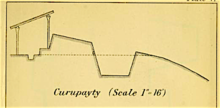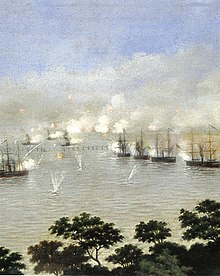Battle of Curupayty
Battle of Curupaytí
Part of: Triple Alliance War
.jpg)
Attack on the positions at Curupaytí. The picture (taken in the late 1890s) shows the battle from the perspective of the Paraguayan defenders.
Major Military Campaigns, Sieges, and Battles of the Triple Alliance War
1st phase: Paraguay's offensives against Brazil and Argentina (1864-1865)
Mato-Grosso campaign - Corrientes - Riachuelo - Yatay - Uruguayana
2nd phase: Allied counter-offensive and war of position before Humaitá (1866-1867)
Itapirú - Estero Bellaco - Tuyutí I - Yataytí Corá - Boquerón - Sauce - Curuzú - Curupaytí
3rd phase: resumption of the allied offensive and conquest of the heartland of Paraguay (1867-1868)
Tuyutí II - Humaitá - Ytororó - Avahy - Itá Ivaté
4th phase: Final offensive of the allies and total defeat of Paraguay (1869-1870)
Piribebuy - Acosta Ñu - Cerro Corá
The Battle of Curupaytí was fought in September 1866 during the Triple Alliance War between Paraguay on the one hand and Argentina and Brazil on the other. An army force composed of Argentine and Brazilian troops, supported by Brazilian river combat ships, attempted to defeat the strong Paraguayan fort of Curupaytí on the banks of the Río Paraguay. The attack on the fort, which was part of the Humaitá-Curupaytí fortress complex, failed with heavy losses for the attackers. The allies then had to postpone their further offensive plans on the Río Paraguay to the north for almost eight months.
Previous story
About three weeks before the attack on the Curupaytí fort, Brazilian units had been able to achieve an initial success against the Paraguayan defensive reduction off Humaitá as part of their advance northward on the Río Paraguay at Curuzú. Since the new Brazilian armored ships had proved to be very successful and their own losses had been comparatively low, the allied leadership hoped for a similarly quick success at Curupaytí. Although this fort was considerably stronger than the one at Curuzú - a fact known to the allies - the Brazilians had since been reinforced by Argentine troops and by two new mortar vehicles, which made a similar success seem possible.
The Paraguayan defense
Compared to the earthworks at Curuzú, the fort at Curupaytí was better and more extensively built with breastworks. Furthermore, numerous guns were not only entrenched, but also camouflaged and partly in covered positions. This protected the artillerymen much more effectively against shrapnel detonated in the air (which had caused a large part of the Paraguayan losses before Curuzú).
The Curupaytí fort had a total of 49 guns, including about two dozen 32-pounders, five lighter 12-pounder field guns, and eight heavy 68-pounder Lancaster guns of British provenance. These heavy guns were capable of firing a cartridge charge (consisting of some 30 iron balls up to 50 mm in diameter) specially developed by the Paraguayans. After the defeat at Curuzú, some 1,700 soldiers had also been ordered to Curupaytí as reinforcements from the main fort of Humaitá, bringing the fort's reinforced garrison to about 5,000 men. In order to improve the defence, the local commander, General José Eduvigis Díaz, also had a 2,000-metre-long neck ditch (about three metres wide and two metres deep) built, which largely shielded the land side of the fort. In addition, obstacles made of felled trees and sharpened wooden stakes were constructed in front of the defensive lines. The Paraguayan troops comprised seven infantry battalions, four smaller but combined cavalry regiments (under Capitán Bernardino Caballero) and one mixed battalion.
The armed forces of the allies
The II Brazilian Army Corps (2º Corpo do Exército Brasileiro), victorious at Curuzú, had been reinforced to about 11,000 soldiers during the first weeks of September. In addition, some 9,000 Argentine soldiers of the I and II Argentine Army Corps (1º & 2º Corpo do Exército Argentino) had arrived in Curuzú since the second week of September. The I Army Corps was commanded by General Wenceslao Paunero. The II Army Corps was under the command of Bartolomé Mitre, President of Argentina, although he was assisted by the experienced Generals Emilio Mitre and Wenceslao Paunero. The commander-in-chief of the Brazilian corps was Almirante Joaquim Marques Lisboa (Marquês de Tamandaré). Subordinate to him was the commander of the army troops, General Antonio Paranhos. In total, the allies had 21 infantry brigades, two cavalry brigades and two mixed light brigades.
The riverine force, composed entirely of Brazilian units, included the three modern ironclads Brasil, Barroso, and Tamandaré, the turret ironclad Lima Barros, the two new mortar ships Forte Coimbra and Pedro Afonso-each equipped with a 70-pounder Whitworth gun-the three (unarmored) larger gunboats Ipiranga, Belmonte, and Parnaiba, and three smaller gunboats. This flotilla, similar to that at Curuzú, was intended to knock down the fort's guns, thus enabling the attacking land forces to storm the defensive works.

Side view resp. schematic view of the Paraguayan positions at Curupaytí (on the left the covered positions, in front the neck trench).
The battle
On the morning of 22 September, at about 7:00 a.m., Brazilian riverine forces approached the fortifications and initially began a bombardment of the Paraguayan installations that lasted nearly five hours. Almost simultaneously, the Curuzú-assembled land forces of the allies began moving northward, with the Brazilians forming the left wing and the Argentine troops the right wing of the army, and slowly advanced on Curupaytí, about six kilometers away.
The failure of the fleet attack
Although the Brazilian ships fired some 5,000 shells and shrapnel at the fort within five hours, the artillery fire remained largely ineffective, with only one of the fort's guns being disabled. On the one hand, the Paraguayan fortifications were very well protected against the shrapnel detonating in the air; on the other hand, the Brazilian ships - for fear of river mines attached to piles near the shore (the loss of the ironclad Rio de Janeiro off Curuzú was still having an effect here) - remained at a comparatively great distance from the fort, which, however, reduced the accuracy of their aim. In addition, the Paraguayans used only about 20 of their guns against the enemy flotilla-the remaining guns were held back in camouflaged positions by order of General Díaz-which left the Brazilians with the impression that the fort was not as heavily fortified as they had assumed and was largely destroyed after the bombardment. This fatal miscalculation was to turn the actual attack by the army troops into a fiasco a short time later.
The Charge
Shortly after 12:00 noon, and after the shelling by the river fleet had ceased, about 8,000 soldiers of the allies - the army had been divided into two assault waves - charged against the fortifications of Curupaytí. The attack was initiated here by the Argentines standing on the right wing. The Paraguayans, whose lines were still almost fully operational, now opened fire with all available (and also camouflaged) guns, whereby especially the cartridges of the heavy 68-pounders claimed terrible victims among the attackers. Hundreds of soldiers were literally torn to pieces or mown down in the advance of the fort's neck trench. The defensive fire was so heavy that only about 70 to 80 soldiers of the allies could even reach the Paraguayan positions. In view of the appalling losses suffered by his Argentine troops, Bartolomé Mitre ordered the cessation of all further attacks at around 14:00. The planned attack of the second meeting of the allies was also cancelled. Around half of the soldiers of the first attack wave lay dead or wounded on the battlefield by midday.
The allies retreated a short time later in the direction of Curuzú. The retreat was relatively disorderly. The last units securing the retreat - Brazilians of the 1st Infantry Brigade - some of them carrying wounded soldiers, arrived there only at about 17:00. This was the end of the battle, also because the Paraguayans did not pursue the retreating enemy. (The order not to pursue had been given directly by Francisco Solano López, who wanted to avoid unnecessary losses after the heavy defeat at Curuzú. However, this prevented General Díaz from inflicting an even heavier defeat on the retreating enemy).

Brazilian tank gunboats during the shelling of Curupaytí.
Search within the encyclopedia